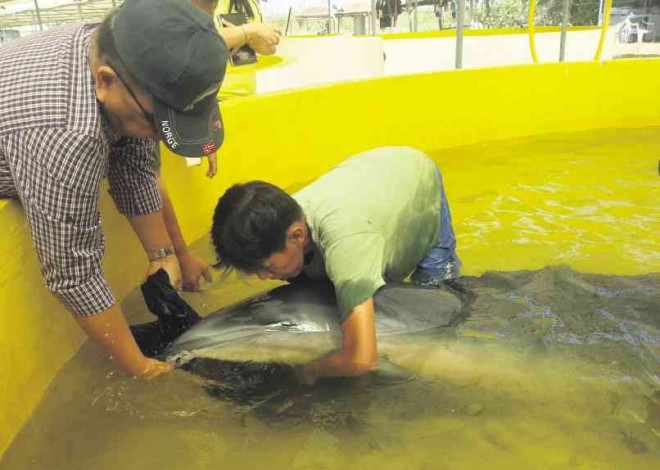No end yet to stranding of dolphins

A 2.4-METER-LONG bottlenose dolphin, found beached in Lingayen town in Pangasinan province, is treated at the National Integrated Fisheries Technology Development Center in Dagupan City. WILLIE LOMIBAO
On Feb. 13 last year, a juvenile spinner dolphin (Stenella longirostris), was found on the beach of Badoc town in Ilocos Norte. It had burns and was in need of immediate medical treatment and rehabilitation.
The female dolphin, named “Valentina” because she was found on the eve of Valentine’s Day, has since regained her health, but her hearing was impaired due to acoustic trauma caused by blast fishing.
Dr. Lemuel Aragones, president of the Philippine Marine Mammal Stranding Network (PMMSN), advised Valentina’s caretakers at a marine park in Zambales against returning her to the wild. When sea mammals lose their hearing, they also lose their capacity to navigate in the ocean and their abilities to find food and to socialize, he said.
“Julius,” a Fraser’s dolphin (Lagenodelphis hosei), however, was not as lucky. He was one of 33 Fraser’s or Sarawak dolphins that beached in the shores of the Lingayen Gulf from Pangasinan to La Union provinces from Jan. 26 to Feb. 5.
Julius was found on the Lingayen beach on Jan. 27 and was taken to Ocean Adventure Marine Park at Subic Freeport in Zambales for medical treatment. He died on Feb. 17.
According to the Bureau of Fisheries and Aquatic Resources (BFAR), 22 of the dolphins had died while eight were released back to the sea. Two were seen alive in the Lingayen Gulf, while Julius died while
undergoing treatment.
It looks like there’s no end yet to marine mammal stranding in the gulf.
On Feb. 20, “April,” a rough-toothed dolphin (Steno bredanensis), was rescued by the PMMSN and local government workers in Sinait, Ilocos Sur province. It was later transferred to a fishpond to allow better rehabilitation.
Unabated blast fishing
In a letter to Nestor Domenden, BFAR Ilocos regional director, Aragones said that while treating the stressed and sick April, he and two other responders heard dynamite blasts in the sea.
“This happened after I interviewed a few locals who admitted that dynamite fishing is still being practiced in their area,” Aragones, a professor at the University of the Philippines’ Institute of Environmental Science and Meteorology, said.
The Ilocos region has had the highest rate of marine mammal stranding in the country in the past five years, most probably because of unabated blast fishing, he said in a telephone interview. He said the dolphin beaching in La Union (two towns) and Pangasinan (nine towns) this year may have been caused by blast fishing.
“When blasting occurs even far from where they are located, sea mammals lose their balance, fall on their side and their noses get clogged and they cannot breathe. This is much like humans, when we sleep on our side and when our noses get clogged so we can’t breathe,” Aragones said.
He said marine mammal stranding and deaths were just the “visible” manifestations of how blast fishing was killing marine animals.
Bigger problems
“There are deeper and bigger problems [due to the impact] of blasting, such as
destruction of corals and killing of all kinds of fish, including the larvae or eggs. But these are not given much attention. Since people react passionately when sea mammals are killed, we are using [cases of]
marine mammal stranding to call attention to illegal fishing’s serious effects on marine life,” he said.
After the beaching of the 33 Fraser’s dolphins in January, the BFAR sent investigation teams to the different coastal towns along the Lingayen Gulf.
Their findings confirmed rampant blast fishing in the gulf facing the West Philippine Sea, said Dr. Samantha Licudine, a veterinarian of the BFAR regional office.
Marine mammals are attracted to the Lingayen Gulf when “acetes” (baby shrimps) are plenty, like when a pod of Fraser’s dolphins was first seen in the waters off Aringay and Agoo towns in La Union on Jan. 26, said Belmor Bugawan, acting head of the fishery resources management division of the BFAR in the Ilocos.
Manuel Ugaban, Aringay municipal agriculture officer, said the dolphins that beached in Barangay (village) Alaska, where blast fishing was once rampant, had wounds that could have been caused by spears or shrapnel from homemade explosives.
“Maybe they got tangled in some nets, or some unscrupulous fishermen pierced them with sharp objects, so they swam to the shore,” he said.
Alaska residents no longer hurt marine mammals, believing that the sea was claiming large sections of their village whenever there is storm surge due to their illegal deeds in the past, Ugaban said.
“Residents now refuse to eat meat of sea mammals,” he said. “Nobody would even buy dolphin meat in the market.”
Aragones said the PMMSN would help the BFAR, local governments and fishing communities in the Ilocos stop or reduce incidents of blast fishing to ensure a healthy coastal and marine environment in the region.














